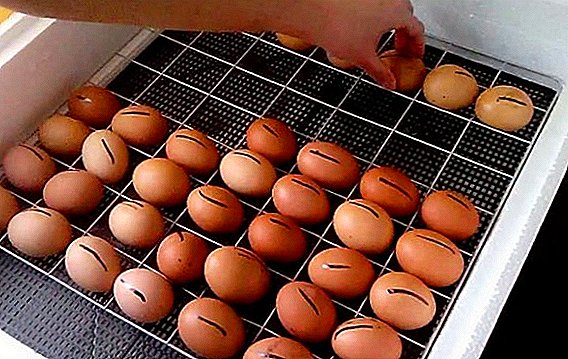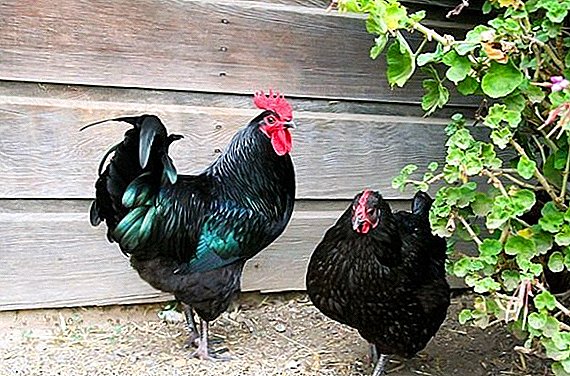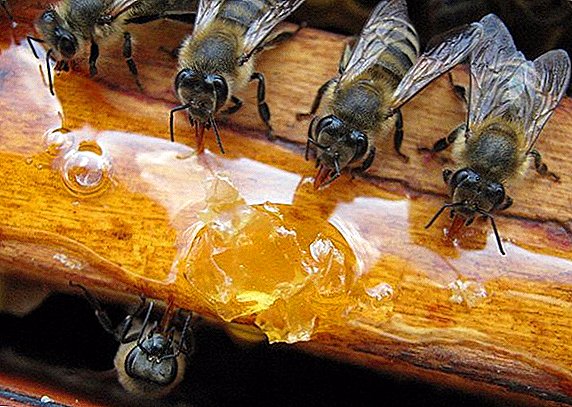 As is known, the breeds of chickens are divided into 3 areas: egg, meat and meat-meat. If your goal is to get as many high-quality eggs as possible from the birds, you should pay attention to the first category. Already more than one year, among the crosses of the broken white, are especially appreciated among the egg layers. They are beautiful, highly productive and unpretentious. What is needed to grow healthy and egg-bearing chickens, read below.
As is known, the breeds of chickens are divided into 3 areas: egg, meat and meat-meat. If your goal is to get as many high-quality eggs as possible from the birds, you should pay attention to the first category. Already more than one year, among the crosses of the broken white, are especially appreciated among the egg layers. They are beautiful, highly productive and unpretentious. What is needed to grow healthy and egg-bearing chickens, read below.
Description
Representatives of the breed "white broken line" is easy to recognize by external signs - they stand out among other varieties. These are very small birds that reach a maximum weight of 1.5 kg (layers) and 2 kg (roosters).
Like all representatives of the egg direction, their body is compact, one might say sporting, in the form of a trapezoid. Located on long, sturdy, not plucked paws of yellow color. The chest and abdomen are not very pronounced. The wings are short.
As the name implies, the body is covered with thick white brilliant plumage. A bright red comb and earrings look beautiful on a small head. Sometimes in the hens, the scallop falls to the side, but more often it still remains in a standing position.  In cocks, the crests are larger, with well-pronounced teeth. Eyes - red-orange. Bill is hard, mature specimens horny. These crosses are the achievement of German breeders, representatives of the company Lohmann Tierzucht GmbH.
In cocks, the crests are larger, with well-pronounced teeth. Eyes - red-orange. Bill is hard, mature specimens horny. These crosses are the achievement of German breeders, representatives of the company Lohmann Tierzucht GmbH.
In order to obtain eggs, such breeds of chickens as “Shaver”, “Minorca”, “Aurora Blue”, “Leggorn”, “Brekel”, “High-Line”, “Brown Nick”, “Iza Brown”, “Loman Brown” are breeding "," Russian White "," Ukrainian Ushanka "," Orlovskaya "," Pavlovskaya "," Pushkinskaya ".
Their task was to breed a highly productive breed, the best in its category. It was such that they turned out in the 1970s - the chicken hen brown was bred and the cross from it was white. Among the ancestors of the latter are local breeds and leggorn white.
Did you know? In the study of the tomb of Tutankhamen, archaeologists were able to find ancient images of chickens, allegedly related to 1350 BC. e. This suggests that keep chickens in the economy was taken a long time ago. Also in Egypt, were found the remains of chickens, according to scientists, dated 685-525 years. BC e.

Advantages and disadvantages of the breed
Breeding cross-country wight has many advantages:
- high productivity;
- low feed intake;
- large eggs;
- early maturation;
- thanks to the thick plumage, they tolerate heat and cold, temperature fluctuations;
- the ability to lay eggs year-round and even during the molting period;
- calm balanced temperament;
- high survival rate;
- unpretentious content.
Disadvantages of crosses are much smaller. Among them:
- noisyness;
- short period of maximum productivity;
- the inability to breed one’s own offspring — one can only renew the livestock by buying new birds or placing eggs in an incubator.

Character and behavior
Due to their compact size and temperament, chickens are very mobile. They easily fly to the perches, move quickly, are almost constantly in motion, which, naturally, has a positive effect on their health.
They calmly relate to the neighborhood with relatives of other breeds, they do not show aggression. However, they are noisy, which, however, is solved by keeping one rooster for 15-20 laying hens. Leaders will be able to establish order in the house and temper the loud clucking klush. Also white crowns are very curious. 
Puberty
Puberty in the hens begins early - already on the 135th day of life. Thus, from 4-4.5 months from the chickens you can expect the first eggs. At the same time, the first clutch is usually not the maximum. Therefore, the number of eggs received for the first time, it is not necessary to judge the productivity of the hen.
Productive characteristics
Chicken hawk egg production is up to 340 eggs per year - which is an excellent result for birds with an egg-bearing direction. Large eggs - 60-65 g, with a white strong shell. With the creation of optimal conditions and the establishment of a balanced diet, the chugs can be carried daily throughout the year.
The maximum productivity of chicken is reached at the age of 160-180 days. But after 80 weeks, their egg production begins to decline. Therefore, to keep the birds longer than this period is impractical. 
Features of the content of the cross
Crosses broken wight feel great in poultry houses with an air temperature of 23-25 ° C. Thanks to their thick plumage and strong immune system, they can live in unheated rooms with a temperature not lower than 5 ° C. However, eggs at this temperature should not wait.
We recommend reading about how to choose the right chicken coop when buying, how to equip it, as well as how best to heat the chicken coop in winter.
It is possible to achieve year-round egg production, provided the heaters are installed in the hen house, it is insulated. In winter, the temperature should not fall below 15 ° C. For normal productivity is important factor in the population of the house. Kuram should be spacious. The recommended settlement density is 2-3 layers per 1 sq. M. m
Like other representatives of the egg-type, the White line pleases its owner with a high level of egg production only if the hygiene standards in the house are observed. Clean, dry and fresh air - a pledge of normal well-being of birds, and hence, excellent productivity.  The ideal option is equipping the house with a high-quality ventilation system. In the absence of such an opportunity - frequent airing through the windows. When airing you need to ensure that chickens are not in a draft.
The ideal option is equipping the house with a high-quality ventilation system. In the absence of such an opportunity - frequent airing through the windows. When airing you need to ensure that chickens are not in a draft.
Another important factor that should be provided in the room where the crosses live is the length of the daylight hours. The coop must have at least one window for daylight penetration.
In the autumn-winter period, additional light sources should be installed (better than fluorescent lamps). Duration of daylight should be no shorter than 12 and no longer than 14 hours.
The coop should be equipped with mandatory devices: feeders, drinkers and nests. The number of nests should be calculated as follows: one piece for 5-6 layers. Feeding trough should be calculated from the parameters of 10-15 cm per individual. Drinking bowls should be 5-6 liters in volume.  The floor should be covered with high-quality bedding from natural (straw, hay, sawdust) or special synthetic materials. A prerequisite for the well-being of the hens is the availability of a walking place.
The floor should be covered with high-quality bedding from natural (straw, hay, sawdust) or special synthetic materials. A prerequisite for the well-being of the hens is the availability of a walking place.
Read more about how to make a chicken coop, aviary, cage, nest and roost for laying hens.
Its parameters should be calculated on the basis of 1 square. m on 1 hen. Feeders and drinkers should also be installed in the aviary. Crosses broken white are suitable for both outdoor and cellular content. Recommended for industrial and farm growing.
Feeding the chickens breed white hawk
Nutrition is of great importance to the productivity of birds - it must be balanced, i.e. it must contain enough vitamins and minerals. The diet may consist of purchased feed, for example, "Premix", with the addition of vegetables and herbs, as well as feed, cooked with his own hands. 
We advise you to read about how to prepare feed for chickens and for adult birds with your own hands.
In the daily menu of chicken must be present:
- cereals (wheat, barley, oats, corn) - 55-60% of the total feed;
- vegetables (potatoes, carrots, beets, cabbage);
- greens (nettle, dandelion, alfalfa, clover) - 30% of the total;
- mineral supplements (calcium, phosphorus, sodium, chlorine);
- vitamins.
The approximate daily menu of the bird can be made as follows:
- corn;
- wet mash;
- boiled potatoes;
- cake;
- a piece of chalk;
- salt;
- bone flour;
- yeast.

It will be useful for you to read about how to make feed for laying hens, how much feed you need for a laying hen per day, and what vitamins the hens need for egg production.
These products should be in the total mass of 120 g per individual. Every day a hen needs 300 kcal and 20 g of protein. About 40 kg of fodder and 15 kg of greens are spent per year on one hen.
It is necessary to feed the hens twice a day: in the mornings and evenings. This applies to those chickens who are in the aviary during the day. If they do not walk, then add daily feeding. In the morning they give grain with vegetables, in the afternoon - mash, vegetables, greens, in the evening - grain.
Important! In addition to food, the bird also needs to be given fresh clean water. It is necessary to equip the chicken coop and the aviary with high-quality drinkers and ensure that the liquid in them does not pollute.
Rearing chicks
As we already mentioned, getting chickens from the previous livestock will not work. The fact is that these layers have no incubation instinct. Therefore, the chickens will need to purchase or grow eggs in the incubator.  In the first 14 days, youngsters can be fed with finely chopped boiled eggs, greens, cereals. After 2 weeks, you can give the kids the starting Premix by adding boiled eggs with greens, cottage cheese, bone and fish meal. In the future, the diet of chickens should be expanded by adding vegetables and grass.
In the first 14 days, youngsters can be fed with finely chopped boiled eggs, greens, cereals. After 2 weeks, you can give the kids the starting Premix by adding boiled eggs with greens, cottage cheese, bone and fish meal. In the future, the diet of chickens should be expanded by adding vegetables and grass.
With regard to the number of feedings per day, then up to 10-14 days of age babies bring food 6 times, up to 1.5 months of age - 5 times, up to 4 months - 4 times. At 1.5-2 months old chickens are separated from roosters.
Learn how to feed and grow chickens.
This is done because the hens require a special diet and a certain amount of feed. Roosters, for weight gain, will need to inject protein and carbohydrate-rich foods. At the same age young chickens can be combined under the same roof with the rest of the population.
Video: proper nutrition and maintenance of chickens An important component of chick maintenance is vaccination and prophylactic administration of antibiotics. Also, in order for the birds to have good health, the young should be released more often for walks.
Breed diseases and prevention
Of course, everyone who grows birds as a business should take care of timely vaccination. If you follow the sanitary and hygienic standards and ensure that chickens do not stay in the draft and do not drink cold water, then there should not be any serious health problems.
Important! Eggs and chickens should be purchased only on proven poultry farms, in order to avoid the purchase of poor-quality or non-pedigree livestock with health problems.
Newly acquired birds should be placed in quarantine and given antibiotics for the purpose of prevention - “Baytril” or “Enroxil” (in the dosage prescribed by the veterinarian) is administered up to 5 days old, and “Nutril selenium” and “Trivitamin” are watered at the age of 5-12 days ".  With poor nutrition, these crosses can suffer from avitaminosis. Eliminate this problem by introducing special vitamin supplements into the feed.
With poor nutrition, these crosses can suffer from avitaminosis. Eliminate this problem by introducing special vitamin supplements into the feed.
Did you know? Chickens make about 30 sounds. With different clucking, they notify their kin about the availability of food, danger, the beginning of the mating season, or about hatching eggs. Before hatching, the chick makes about 10 sounds to communicate with mom. In addition, scientists have proven that these birds have feelings and the ability to empathize, sympathy or antipathy.Thus, chickens do not accidentally have a lot of positive characteristics and feedback from breeders. In terms of egg production, few people compare with them. High productivity, unpretentiousness and low costs for the purchase of feed make their breeding cost-effective.












